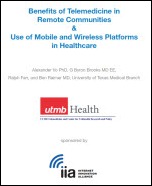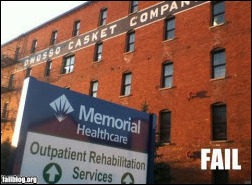Traditionally Professional Courtesy is something that physicians gave each other - but we had to be careful with it when…
News 10/7/11
The Cerner Health Conference starts Saturday in Kansas City, with more than 10,000 attendees expected.
Reader Comments
![]() From Tired CIO: “Re: McKesson Paragon. A recent invite was sent to the Paragon user community for a Webinar that will discuss ‘product line updates’ from company executives. This is a first, as far as I know. Also sent was an e-mail blast informing the clients that the support line for Paragon will be re-routed to the HPF division on Friday so that all Paragon employees can attend an off-site meeting (also a first.) It’s looking like there may be something in the works for Paragon.” Unverifed, but that makes a couple of recent rumblings along those lines.
From Tired CIO: “Re: McKesson Paragon. A recent invite was sent to the Paragon user community for a Webinar that will discuss ‘product line updates’ from company executives. This is a first, as far as I know. Also sent was an e-mail blast informing the clients that the support line for Paragon will be re-routed to the HPF division on Friday so that all Paragon employees can attend an off-site meeting (also a first.) It’s looking like there may be something in the works for Paragon.” Unverifed, but that makes a couple of recent rumblings along those lines.
![]() From Joseph Prang: “Re: 5010 upgrades. Most of the 5010 work is being done by clearinghouses, but practice management system vendors are sending daily faxes and e-mails to their customers demanding that they upgrade to be 5010 compliant. Why would practices need to upgrade unless they are submitting directly to a payor or their clearinghouses are requiring 5010 claim input (which none are, as far as I know?) It should not matter. Practices are coughing up big bucks to get their upgrades in, but should be able to submit in Sanskrit if the clearinghouses do their job.” We talked to a couple of other in-the-know folks, who agreed.
From Joseph Prang: “Re: 5010 upgrades. Most of the 5010 work is being done by clearinghouses, but practice management system vendors are sending daily faxes and e-mails to their customers demanding that they upgrade to be 5010 compliant. Why would practices need to upgrade unless they are submitting directly to a payor or their clearinghouses are requiring 5010 claim input (which none are, as far as I know?) It should not matter. Practices are coughing up big bucks to get their upgrades in, but should be able to submit in Sanskrit if the clearinghouses do their job.” We talked to a couple of other in-the-know folks, who agreed.
![]() From Emmett Hunter: “Re: Cerner. Making an acquisition Friday. Cloud-related.” Unverified.
From Emmett Hunter: “Re: Cerner. Making an acquisition Friday. Cloud-related.” Unverified.
![]() From Blue Devil: “Re: Todayskick.com. Were you consulted prior to launch?” Brilliant. A site dedicated to showing off your shoes and shopping for new ones. Nope, I wasn’t consulted, which is likely why there appears to be a dearth of sexy pumps. I might have to go through my closet this weekend and upload my Alexander McQueen / Stuart Weitzman / Christian Louboutin collections.
From Blue Devil: “Re: Todayskick.com. Were you consulted prior to launch?” Brilliant. A site dedicated to showing off your shoes and shopping for new ones. Nope, I wasn’t consulted, which is likely why there appears to be a dearth of sexy pumps. I might have to go through my closet this weekend and upload my Alexander McQueen / Stuart Weitzman / Christian Louboutin collections.
![]() From AtlantaHITGal: “Re: Jay Deady of Awarepoint has hired two employees away from McKesson in what looks like some sort of package deal since both resigned the same day this week. I know McKesson isn’t pleased, but I’m not sure they can do anything to stop the talent exodus that began two years ago.” I omitted the employee names since I didn’t verify their departure.
From AtlantaHITGal: “Re: Jay Deady of Awarepoint has hired two employees away from McKesson in what looks like some sort of package deal since both resigned the same day this week. I know McKesson isn’t pleased, but I’m not sure they can do anything to stop the talent exodus that began two years ago.” I omitted the employee names since I didn’t verify their departure.
![]() From Gitane: “Re: Swedish Medical Center alliance with Providence Health Services. In a FAQ document for employees, Epic is mentioned briefly. Document attached.”
From Gitane: “Re: Swedish Medical Center alliance with Providence Health Services. In a FAQ document for employees, Epic is mentioned briefly. Document attached.”
HIStalk Announcements and Requests
![]() One more thing to ensure HIT well-roundedness: read HIStalk Practice. This week’s highlights include wine and acrobatics in the MGMA exhibit hall (look for the Medic and IDX booths in the video.) Private companies outshine public ones in the KLAS mid-year rankings of ambulatory EHRs. Navicure readies for ICD-10. Physicians believe that decision support tools and AI will prevent diagnostic errors. Rob Culbert advises on the the right way to subsidize employed physicians. Stay in the know by signing up for e-mail updates. Thanks for reading.
One more thing to ensure HIT well-roundedness: read HIStalk Practice. This week’s highlights include wine and acrobatics in the MGMA exhibit hall (look for the Medic and IDX booths in the video.) Private companies outshine public ones in the KLAS mid-year rankings of ambulatory EHRs. Navicure readies for ICD-10. Physicians believe that decision support tools and AI will prevent diagnostic errors. Rob Culbert advises on the the right way to subsidize employed physicians. Stay in the know by signing up for e-mail updates. Thanks for reading.
![]() Listening: The Killers, grandiose pop that sometimes sounds like U2, sometimes 80s Britpop, sometimes Muse. The Las Vegas band is hardly obscure: they’ve sold millions of albums, won a slew of awards, and on Independence Day last year, played in a salute to the military on the White House lawn at the President’s invitation.
Listening: The Killers, grandiose pop that sometimes sounds like U2, sometimes 80s Britpop, sometimes Muse. The Las Vegas band is hardly obscure: they’ve sold millions of albums, won a slew of awards, and on Independence Day last year, played in a salute to the military on the White House lawn at the President’s invitation.
![]() Inga thinks we should run more stuff about homecare, assisted living, and long term care IT. Neither of us knows too much about it. What do you think? Is there an audience for that and any experts who might help us out?
Inga thinks we should run more stuff about homecare, assisted living, and long term care IT. Neither of us knows too much about it. What do you think? Is there an audience for that and any experts who might help us out?
![]() Jobs on the Job Board: Regional Director of Enterprise Sales, Product Director – Acute Revenue Cycle Solutions, Implementation Project Manager. On Healthcare IT Jobs: Pharmacy Informatics Analyst, Solution Sales Executive – Microsoft HSG, HL7 Interface Analyst, Epic Consultant Manager.
Jobs on the Job Board: Regional Director of Enterprise Sales, Product Director – Acute Revenue Cycle Solutions, Implementation Project Manager. On Healthcare IT Jobs: Pharmacy Informatics Analyst, Solution Sales Executive – Microsoft HSG, HL7 Interface Analyst, Epic Consultant Manager.
Acquisitions, Funding, Business, and Stock
Navigant acquires Paragon Health, a practice management and consulting firm specializing in cardiovascular practices.
Practice management and billing software provider Kareo, Inc. closes a $10 million equity investment led by Greenspring Associates. Kareo, which has grown more than 100% per year for the past three years, will use the capital to expand its sales and marketing initiatives and to add at least 30 employees by the end of the year.
Wireless asset tracking vendor AeroScout acquires Sentient Health, which offers medical supply inventory management tools.
Sales
PeaceHealth signs agreement through GE Healthcare to upgrade to Streamline Health’s AccessAnyWare v5.1.
Advocate BroMenn Medical Center and Advocate Eureka Hospital (IL) select MediRevv to provide A/R management services.
Ventura County (CA) enters into a $32 million contract with Cerner to provide EHR to the county’s hospitals.
Children’s of Alabama selects iSirona’s device connectivity solution to deliver data from medical devices to its Allscripts EMR.
People
Aegis Health Group hires William Walker (Medkinetics) as VP of IT services.
Dell names Andrew W. Litt, MD (Litt Healthcare Ventures, NYU Langone Medical Center) chief medical officer for the company’s Healthcare and Life Sciences Services division.
Announcements and Implementations
Merge Healthcare introduces Merge Honeycomb, a cloud-base medical imaging sharing network that is open for use by anyone at no charge.
Iatric Systems earns Surescripts e-prescribing certification for its discharge instructions function that allows prescription routing to retail pharmacies in all states.
Medical Specialists, an Indiana medical practice, uses Shareable Ink and its Allscripts EHR to, in its words, “merge technology and personalized healthcare.”
Verizon Connected Healthcare Solutions and Duke University will collaborate on projects for mobile health and consumer healthcare education, with Verizon providing the infrastructure and Duke contributing people and intellectual property.
Government and Politics
Meaningful Use by the numbers:
- 88,399 physicians and hospitals had signed up for the Medicare program by the end of September; an additional 24,030 registered for the Medicaid program.
- As of September 30, CMS had paid more than $850 million in EHR incentives ($357 million for Medicare and $493 million for Medicaid.)
- Medicare incentive payments have been paid to 3,772 physicians and 158 hospitals.
The Medicare Payment Advisory Commission (MedPAC) votes to endorse a plan to repeal the sustainable growth rate (SGR) formula for Medicare physician pay and replace it with one that keeps rates steady for primary care physicians over the next decade and cuts other physician services 5.9% for three years, then freezes those rates for seven years.
A UTMB report looks at the use of telemedicine and the use of mobile and wireless technologies in healthcare. It’s brief, but interesting. The site of its Center for Telehealth Research and Policy has good resources.
Other
Computer Science Corporation (CSC) shareholders file a class action lawsuit against the company over its participation in the UK’s NPfIT project, alleging that CSC deliberately misled them with overly optimistic projections of its ability to deliver, its financial performance, and the viability of the Lorenzo software from subcontractor iSoft, claiming the company knew for years that it was “dysfunctional and undeliverable.”
![]() Plastic surgery for men is on the rise, with facelifts up 14%. Rhinoplasty is the procedure of choice for men, though otoplasty and liposuction are popular as well. Anyone want to venture a guess what surgical procedure remains the top pick for women?
Plastic surgery for men is on the rise, with facelifts up 14%. Rhinoplasty is the procedure of choice for men, though otoplasty and liposuction are popular as well. Anyone want to venture a guess what surgical procedure remains the top pick for women?
![]() I’ve read a bunch of Steve Jobs quotes in the last 24 hours. Here’s my favorite:
I’ve read a bunch of Steve Jobs quotes in the last 24 hours. Here’s my favorite:
Remembering that you are going to die is the best way I know to avoid the trap of thinking you have something to lose. You are already naked. There is no reason not to follow your heart. Stay hungry. Stay foolish.
![]() I’ve enjoyed watching this excellent video of Steve Jobs delivering Stanford’s 2005 commencement address. It’s like Apple’s products: carefully designed, casually presented, and deceptively simple. The message of finding a job that matches what you love to do is powerful. On death: “I’ve looked in the mirror every morning and asked myself, ‘If today were the last day of my life, would I want to do what I am about to do today?’ Whenever the answer has been ‘no’ for too many days in a row, I know I need to change something. Remembering that I’ll be dead soon is the most important tool I’ve ever encountered to help me make the big choices in life.”
I’ve enjoyed watching this excellent video of Steve Jobs delivering Stanford’s 2005 commencement address. It’s like Apple’s products: carefully designed, casually presented, and deceptively simple. The message of finding a job that matches what you love to do is powerful. On death: “I’ve looked in the mirror every morning and asked myself, ‘If today were the last day of my life, would I want to do what I am about to do today?’ Whenever the answer has been ‘no’ for too many days in a row, I know I need to change something. Remembering that I’ll be dead soon is the most important tool I’ve ever encountered to help me make the big choices in life.”
![]() Athenahealth Chairman and CEO Jonathan Bush writes a guest post for Forbes titled Hospitals Might Be Heading Into Trouble, where he likens the “buying binge” and excessive borrowing of hospitals acquiring physician practices to that of Fannie Mae in pushing people into houses they couldn’t afford. He predicts that (a) hospital systems will fail in numbers too big to be bailed out by investors or the government, or (b) hospitals will complete their vertically integrated monopolies and strong-arm higher patient volumes and prices. A snip:
Athenahealth Chairman and CEO Jonathan Bush writes a guest post for Forbes titled Hospitals Might Be Heading Into Trouble, where he likens the “buying binge” and excessive borrowing of hospitals acquiring physician practices to that of Fannie Mae in pushing people into houses they couldn’t afford. He predicts that (a) hospital systems will fail in numbers too big to be bailed out by investors or the government, or (b) hospitals will complete their vertically integrated monopolies and strong-arm higher patient volumes and prices. A snip:
In my ‘hospitals gobbling docs’ scenario, software is the bottleneck to profitability. The supposed enabler of the referrals that the above business model is predicated on, is not working to that end. Why would it be? Software is not a web-native connected system. It doesn’t update when the rules change. Software doesn’t even let you send patients from one hospitals to the next (unless one is owned by the other and using the same server – can you imagine? In this day and age?). In fact, outside of vertically integrated systems like Kaiser Permanente and Cleveland Clinic (and they are highly-specialized solutions) and a few others, you’d be hard-pressed to see any cases where software is greasing the referral wheels. In other words software is mucking up the model.
![]() Weird News Andy channels Buster Keaton in his wordless wry commentary. It’s pretty common to see cemeteries adjoining hospitals in the South, leading to the inevitable knee-slapping quip by one’s father driving the family car, “People are dying to get out of one and into the other.”
Weird News Andy channels Buster Keaton in his wordless wry commentary. It’s pretty common to see cemeteries adjoining hospitals in the South, leading to the inevitable knee-slapping quip by one’s father driving the family car, “People are dying to get out of one and into the other.”
![]() A six-year-old boy is treated by a hospital ED for a broken wrist. Three months later, the boy suffers permanent brain damage after being beaten by his mother’s boyfriend, who walks away with two misdemeanor charges and probation. The boy’s father sues the boyfriend and the hospital, claiming the ED doctors should have suspected child abuse from the broken wrist, requiring them to contact authorities. The boyfriend ignores the suit and the hospital prevails in two courts, but another court reverses the decision. This time, the jury finds the hospital negligent and orders it to pay the family $25 million.
A six-year-old boy is treated by a hospital ED for a broken wrist. Three months later, the boy suffers permanent brain damage after being beaten by his mother’s boyfriend, who walks away with two misdemeanor charges and probation. The boy’s father sues the boyfriend and the hospital, claiming the ED doctors should have suspected child abuse from the broken wrist, requiring them to contact authorities. The boyfriend ignores the suit and the hospital prevails in two courts, but another court reverses the decision. This time, the jury finds the hospital negligent and orders it to pay the family $25 million.
Sponsor Updates
- Rockcastle Regional Hospital and Respiratory Care Center (KY) shares clinical data with the Kentucky HIE using the Healthcare Management Systems Connex interoperability platform.
- Nuesoft Technology names Cornerstone University and Colorado College the Fall 2011 winners of its College Health Scholarship program.
- Merge Healthcare releases an eBook entitled Meaningful Use Guide for Radiology.
- Metropolitan Medical Services partners with iMDsoft to offer the MetaVision Anesthesia Information Management System.
- ZirMed and HEALTHCAREfirst announce a partnership to offer an RCM solution to home health and hospice care agencies.
- nVOQ and Health Language Inc. will collaborate to deliver the voice recognition solution Say It for Health Care.
- HITEC-LA selects NextGen Healthcare as a preferred vendor.
- Wellsoft receives the highest marks for EDIS solutions in the recent KLAS EDIS report.
- JHIM highlights three hospitals using T-SystemEV to attain Meaningful Use in the ED.
- EDIMS will participate in the ACEP 2011 Scientific Assembly October 15-18 in San Francisco.
- New Zealand-headquartered Orion Health celebrates the opening of its Paris office with an event at the New Zealand Ambassador’s residence in Paris.
EPtalk by Dr. Jayne
I’m waiting anxiously to hear what the Institute of Medicine has to say tomorrow regarding essential health benefits. As part of the Affordable Care Act, insurers will be required to cover these essential benefits across 10 categories that include professional services, drugs, hospital care, and laboratory services.
The Washington Post feature Wonkblog covered this in an easy-to-read article. I need to be more careful, though, because I was reading this piece while multitasking (aka “not paying attention”) during a Big Meeting and apparently had some facial leakage that might have been perceived as smirking.
My favorite quote is from Tekisha Dwan Everette, director of federal affairs for the American Diabetes Association: “You have to be cognizant that you can’t narrowly include every miniscule coverage option or the whole thing will implode on itself.” I love her use of “implode” and think it’s a perfect descriptor for what we’ll be seeing over the next few years. A close second from National Health Council Vice President Marc Boutin: “As we moved through some of the actuarial analysis, we found that covering everything really isn’t affordable.” Duh. Did they really need to ask an actuary about that, or just a middle school algebra student?
I wonder how many patients will lobby for coverage of the new gray hair prevention pill under development by cosmetic giant L’Oreal? Patients will have to start taking it daily at least 10 years before their hair starts turning gray and then continue taking it for life. I wish I had known about this before I crossed the line into IT administration. I hope they include a Magic 8-Ball to help predict when patients might go gray.
Although many states have already started issuing Meaningful Use checks, providers in the Beehive State can start applying for their piece of the pie starting Monday. For those of you who have forgotten those state nicknames you learned in fifth grade, let me Google that for you: Utah.
Quirky FDA approval: A gel called LeGoo has been approved to temporarily plug small blood vessels during bypass surgeries. It typically dissolves after about 15 minutes, but can be eliminated earlier with application of a cold pack. The FDA wisely warns physicians not to use it on vessels that deliver blood to the brain. Duh #2 of the day.
A new book The Web-Savvy Patient instructs patients facing a medical crisis how to best use the Internet to be an informed patient. Tips include how to tell the difference between good information and poor or vendor-sponsored information. It encourages readers to populate a Personal Health Record to centralize their health information.
Inga scooped me earlier this week with photos from the eClinicalWorks National Users Conference. Although my contacts weren’t as fast with their smart phones, they did deliver the goods. According to my roving reporter, the highlight of the exhibit hall was the Harlem Globetrotters guy and the basketball setup at the Emdeon booth. I know some other meetings are coming up this fall – and I hope to see more submissions from readers. Extra consideration will be given to photos that feature excellent cocktails, costumes, celebrities, or general mayhem. Cerner, AMIA, and NextGen attendees, I’m counting on you!
Contacts
Mr. H, Inga, Dr. Jayne, Dr. Gregg.



















I keep wondering if one day I’ll have an epiphany and get where Jonathan Bush is coming from.
Seems like he couldn’t hit a pothole in his local freeway and not find a way to blame “software” as the root cause of the very existence of the pothole. If only it was
webnetenabledscripedtbutnotprogrammedinanywayresemblingsoftware,yetavailableonascreenconnectedtoaprocessorbutnotprocessingactualsoftwarecodeinsomesortofstrangeetherealway
then he wouldn’t have hit a pothole.
I’ll keep working at understanding how his software running on a web server at one of his data centers is in some magical way different than other people’s software running on a web server in someone else’s data center.
Doesn’t Siemens have some dusty old patent on a breakthrough technology called “Remote Computing Option” (RCO for short) that they could use to put an end to this incessant dribble?
Re: Longterm & home care – I agree with Inga, these are the forgotten children of health IT. Homecare is dominated by clunky versions of Allscripts and McKesson, yet thousands of home care nurses are lugging laptops into patient homes every day trying to document against rigorous federal standards. Forget about long-term care, it is essentially completely paper-based. Recently when I worked as a supervisor in an LTC short-term rehab facility, it would take me four hours to admit a patient – all on paper – pathetic. The only continuity of care with hospitals and physician offices was hand-written W10s and phone calls documented on sticky notes (the paper kind). The only person with an HIT computer in LTC is the MDS Coordinator, who manually transfers clinical documentation from paper into an MDS application. Huge data sets required by home care (OASIS) and long-term care (MDS) are unknown in the general HIT world but have informed the federal government for years as it plans the national reporting methodology that all providers will soon be mandated to provide. Sadly, neither home care nor LTC managers can actually get the data to use in-house in a meaningful way, it is stored and reported only via centralized functions (Home Care Compare etc). This is the most under-served area of health information technology. The rationale has been “LTC can’t afford it”. But staff satisfaction levels in LTC has to be the worst – totally over-worked staff and repressively antiquated workflows. Both home care and LTC sit right in the middle of the health care continuum, but without better IT systems they can hardly participate in any HIE. Hopefully others might comment on models that have worked better in other states than mine.
Joseph Prang: Re: 5010 upgrades question when Clearinghouses can be the remedy… Can you say oldest revenue generating method in the playbook? Governmental requirement that allows for upgrades to get folks to the current version and gain revenue in the process…
Women’s most popular plastic surgery – I’m not sure if it is the most popular but one that I’m hearing more about is the ‘butt lift’. Who would have thunk it!
Jonathan Bush’s comments sound a bit self-serving as he only talks about internal HIS systems on a client server model and of course athena clinicals is cloud-based. And while I did not read is full commentary, what he seems to have missed is the entire enterprise HIE market that is quite robust and growing faster than the EHR market. The reason, quite simple:
Adopting and deploying an HIE to connect all those far-flung practices affiliated with a given hospital/mother-ship to drive referrals. It is arguably the leading driver of HIE adoption at this time.
Inga thinks we should run more stuff about homecare, assisted living, and long term care IT. Neither of us knows too much about it. What do you think? Is there an audience for that and any experts who might help us out?
Here’s my vote for it. Any spotlight on this sector to ultimately improve care would be good. As the baby boom wave hits this market in increasing volumes, better efficiency and communications will be welcomed. After spending several years as a caregiver of an elderly parent, I can personall attest to the fact that the ambulatory/hospital technology make this sector look like Bedrock from the Flinstones…
@bignurse
Home health and long-term care haven’t been ignored. They just don’t wanna pay for the technology. Do they want cutting-edge information systems? Yeah. Is the ROI there to justify that kind of purchase? No. There’s no pot of gold from CMS coming their way to implement an EHR, so why bother? It’s unfair to say this area is neglected, because it’s not. Just because your facility doesn’t have an EHR doesn’t mean none of them do; lots of facilities use adapted platforms from the major vendors, and many of the big boys in the industry have homegrown platforms. The home health stuff out there may not look that cool, but home health agencies aren’t paying for cool – they’re paying for functional. Without government dollars raining from the sky, the people who run long-term care and home health businesses are actually making sensible decisions in their IT purchases. Imagine that.
Just to add to Bignurse’s excellend comment, in the shifting healthcare landscape (including accountable care in its various forms) where risk sharing ansd a shift to more ambulatory care will be the norm, the lack of actionable data from these areas will become more and more exposed. A major problem in many cases is that it is a more fractured marketplace with no central control and no clear incentive to collaborate. This is unlikely to change since the reimbursements, for LTC at least, are a short term disincentive for HCO investment. And no one apparently looks at long term financials anymore…
Wow, two comments in one day and none of them music related.
In my expereince, the “buying binge” that Mr. Bush talks about is being driven just as much by doctors wanting to be employed as a hedge on future uncertainty. Many hospitals I have talked to have their pick of physicians and do not immediately “gobble up” all comers. While it is true that the prime motivation is capturing referrals, there are a whole host of tactics to attract independent physicians that do not include employment.
Whether this turns out to be another repeat of past failures (if the future risk goes away, physicians will get the itch to go independent again for sure) that remains to be seen. All businesses operate in cycles. The employment trend may stall or fade, but I have doubts as to whether the more holistic approach to patient care – and reimbursement – is going away any time soon.
In regards to the 6 yr old boy that sadly suffered brain damage at the hand of his mother’s boyfriend “The boyfriend ignores the suit and the hospital prevails in two courts, but another court reverses the decision. This time, the jury finds the hospital negligent and orders it to pay the family $25 million” Where was the Mother in all this?
Can you do more discussions about IT? How IT gets caught between the customer and the vendor? How IT doesn’t get very much more information than the users they support but has to figure it all out when the vendor isn’t providing the knowledge exchange needed. The IT messenger takes the shots.
Also help unveil the mystery of what IT does – in some organizations no value and not understood. I see IT colleagues working to exhaustion to only find out in general the misconception is IT has done nothing.
The IT role is often cloudy in Healthcare- how does the gap get bridged and value earned is out in the daylight? How do we get the positive out there and not get labeled negative for the vendors?
Regarding LTC anf Homecare: I would love to see more about this topic. I am the IT DIrector in a small hospital that also has an Assisted Living/Nursing home. We atarted using common EHR that has some anursing Home functionality, but it was totally inadequate. We are now implementing LTC-specific software. We expect to be essentially paperless by next March. It would be great to hear what others have done, but my sense is that we will be a pioneer with how much functionality we are deploying.
And by the way, I think the only reason this is possible is that we have a significant IT department in the Hospital to do it. I have yet to see a LTC facility that has trure “IT” staff! The margins are just too slim.
I am surprised by your response to Joseph Prang. 5010 is a huge change, with over 850 pages of changes, which require not only EDI format changes, but product functionality and data capture/new content changes as well. While clearinghouses will manage the transactions between trading partners, it is the practice management and HIS systems that need to contain required new content for 5010. (In other words, new data elements…) Most vendors who provide both practice management systems and hospital billing systems have modified their respective products’ functionality in order to allow the users to capture, store and output the new content. Clinics and hospitals need to listen to their software vendors and upgrade soon. The 5010 deadline is quickly approaching and the clearinghouse vendors aren’t going to save the day.
I agree with LeftCoaster and several others, above.
In addition, Version 5010 sets the stage for ICD-10 and must be adopted before the ICD-10 code sets. For example, the current transaction version, version 4010, lacks the means to identify the code set being used on the claim. Since version 5010 will be used to report codes from either ICD-9 CM or the ICD-10 code sets depending on the date of service, version 5010 has added a qualifier or “flag” (and increased the field size by one-digit) to indicate which code set is being used. Also, Version 5010 has increased the ICD-10 code field size from 5 to 7 bytes as well as the number of diagnosis codes allowed on a claim. So, unless this physician practice does not plan or want to be reimbursed after 10/01/2013 using ICD-10 codes, then it’s OK,
Re. Jonathan Bush ‘hard-pressed to see any cases where software is greasing the referral wheels’…. UPMC is using a little-known software system called Referral+ for it’s 20+ hospital network that has it business booming, since it owns many of the referred out facilities. The hospital’s liaison team handling referral cases complete electronic templates (mostly pre-populated from EHR data) that contain extraordinary amounts of information for the referral agencies. Contrary to Mr. Bush’s statement though, the system does contain every facility in the tri-state area (the patients can generally pick their destination) with the ability to send patient information to any of them at the click of a button.
“Inga thinks we should run more stuff about homecare, assisted living, and long term care IT.”
Inga is absolutely right. Bignurse paints a bleak picture and it definitely rings true in some ways, but there is much being done to try to push LTC into the present.
I certainly don’t consider myself an expert, but I try to keep up with the industry and would be happy to share what I learn.
This year I’ve had the privilege and the pleasure of attending the AHIMA Long-Term and Post-Acute Care HIT Summit, the AHCA/NCAL Convention and I’ll be attending the LeadingAge (formerly AAHSA) & IAHSA global aging conference next week.
Let me know if I can be of any help.